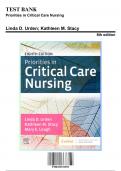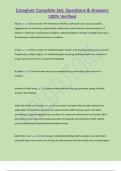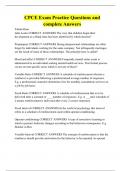Linda D. Urden; Kathleen M. Stacy
TEST BANK
Priorities in Critical Care Nursing
8th edition
9780323531993 Table of content
Chapter 1 Caring for the Critically Ill Patient
Chapter 2 Ethical and Legal Issues
Chapter 3 Patient and Family Education
Chapter 4 Psychosocial Alterations
Chapter 5 Nutritional Alterations
Chapter 6 Gerontologic Alterations
Chapter 7 Pain and Pain Management
Chapter 8 Sedation and Delirium Management
Chapter 9 End-of-Life Care
Chapter 10 Cardiovascular Clinical Assessment and Diagnostic Procedures
Chapter 11 Cardiovascular Disorders
Chapter 12 Cardiovascular Therapeutic Management
Chapter 13 Pulmonary Clinical Assessment and Diagnostic Procedures
Chapter 14 Pulmonary Disorders
Chapter 15 Pulmonary Therapeutic Management
Chapter 16 Neurologic Clinical Assessment and Diagnostic Procedures
Chapter 17 Neurologic Disorders and Therapeutic Management
Chapter 18 Kidney Clinical Assessment and Diagnostic Procedures
Chapter 19 Kidney Disorders and Therapeutic Management
Chapter 20 Gastrointestinal Clinical Assessment and Diagnostic Procedures
Chapter 21 Gastrointestinal Disorders and Therapeutic Management
Chapter 22 Endocrine Clinical Assessment and Diagnostic Procedures
Chapter 23 Endocrine Disorders and Therapeutic Management
Chapter 24 Trauma
Chapter 25 Burns
Chapter 26 Shock, Sepsis, and Multiple Organ Dysfunction Syndrome
Chapter 27 Hematologic Disorders and Oncologic Emergencies Priorities in Critical Care Nursing 8th edition Chapter 1: Caring for the Critically Ill Patient MULTIPLE CHOICE 1. Which of the following units can provide high quality and cost effective care for patients who
are less complex, more stable, and have a decreased need for physiologic monitoring could be placed on? a.intensive care units
b.triage units
c.progressive care units
d.medical surgical units
ANS: C A growing trend in acute care settings is the designation of progressive care units, considered to be part of the continuum of critical care. In past years, patients who are placed on these units would have been exclusively in critical care units. However, with the use of additional technology and monitoring capabilities, newer care delive ry models, and additional nurse education, these units are considered the best environment. The patients are less complex, more stable, have a decreased need for physiologic monitoring, and more self -care capabilities. They can serve as a bridge between cr itical care units and medical -surgical units, while providing high quality and cost effective care at the same time. 2. _____ have a broad depth of knowledge and expertise in their specialty area and manage
complex clinical and system issues. a.SCCMs
b.APNs
c.CNSs
d.AACNs ANS: B APNs have a broad depth of knowledge and expertise in their specialty area and manage complex clinical and systems issues. CNSs serve in specialty roles that use their clinical, teaching, research, leadership, and consultati ve abilities. SCCM stands for the Society of Critical Care Medicine. AACN is the American Association of Critical -Care Nurses. 3. _____ are instrumental in ensuring care that is evidence based and that safety programs are in place. a. CNSs b. APNs c. SCCMs d. AACNs ANS: A CNSs serve in specialty roles that use their clinical, teaching, research, leadership, and consultative abilities. They are instrumental in ensuring that care is evidence based and that safety programs are in place. APNs have a broa d depth of knowledge and expertise in their specialty area and manage complex clinical and systems issues. SCCM stands for the Society of Critical Care Medicine. AACN is the American Association of Critical -Care Nurses. 4. The _____ administers many critic al care certifications exams for registered nurses. a. CNS b. APN c. SCCM d. AACN ANS: D AACN is the American Association of Critical -Care Nurses. CNSs serve in specialty roles that use their clinical, teaching, research, leadership, and consultative abilities. They are instrumental in ensuring that care is evidence based and that safety progr ams are in place. APNs have a broad depth of knowledge and expertise in their specialty area and manage complex clinical and systems issues. SCCM stands for the Society of Critical Care Medicine. 5. Emphasis is on human integrity and stresses the theory th at the body, mind, and spirit are interdependent and inseparable. This statement describes which methodology of care? a. Holistic care b. Individualized care c. Cultural care d. Interdisciplinary care ANS: A Holistic care focuses on human integrity and stresses that the body, mind, and spirit are interdependent and inseparable. Individualized care recognizes the uniqueness of each patients preferences, condition, and physiologic and psychosocial status. Cultur al diversity in health care is not a new topic, but it is gaining emphasis and importance as the world becomes more accessible to all as the result of increasing technologies and interfaces with places and peoples. Interdisciplinary care is care among a va riety of health care professionals with the patients health as the common goal. 6. The AACN has developed short directives that can be used as quick references for clinical use that are known as a. Critical Care Protocol. b. Practice Policies. c. Evidenc e-Based Research. d. Practice Alerts. ANS: D The AACN has promulgated several evidence -based practice summaries in the form of Practice Alerts. Evidence -based nursing practice considers the best research evidence on the care topic along with clinical expertise of the nurse, and patient preferences. Critical care protocol and practice policies are established by individual institutions. 7. A specific therapy or care that is an option to what is considered conventional treatment of a condition is known a s a. Guided Imagery. b. holistic care. c. complementary care. d. individualized care. ANS: C Complementary therapies offer patients, families, and health care providers additional options to assist with healing and recovery. The term complementary was proposed to describe therapies that can be used to complement or support conventional treatments. 8. Animal assisted, guided imagery, and massage are all examples of a. alternative therapy. b. holistic care. c. complementary care. d. individualized care. ANS: C The term complementary was proposed to describe therapies that can be used to complement or support conventional treatments. Spirituality, prayer, guided imagery, massage, and animal -
assisted therapy are all examples of complementary care. Alternative denotes that a specific therapy is an option or alternative to what is considered conventional treatment of a condition or state. Holistic care focuses on human integrity and stresses that the body, mind, and spirit are interdependent and insepa rable. Individualized care recognizes the uniqueness of each patients preferences, condition, and physiologic and psychosocial status. 9. A patient was admitted to a rural ICU in Montana. Critical care nurses are assisting with monitoring and care of the p atient from the closest major city. This is an example of a. telemedicine. b. tele-ICU. c. tele-informatics. d. tele-hospital. ANS: B Telemedicine was initially used in outpatient areas, remote rural geographic locations, and areas where there was a dearth of medical providers. Currently, there are tele -ICUs in areas where there are limited resources onsite. However, experts (critical care nurses, intensivists) are located in a central distant site. 10. Working with individuals of other professions to maintain a climate of mutual respect and shared values best describes the concept of a. interprofessional teamwork and team -based care. b. values and ethics for interprofessional practice. c. interprofessional communication. d. roles and responsibilities for collaborative practice. ANS: B Values and ethics for interprofessional practice mean working with individuals of other professions to maintain a climate of mutual respect and shared values. Roles and responsibilities for collaborative practice include using knowledge of ones own role and the roles of other professions to appropriately assess and address the health care needs of the patients and populations served. Interprofessional communication includes communicating with patients, families, communities, and other health professionals in a responsive and responsible manner that supports a team approach to maintaining health and treatment of disease. Interprofessional teamwork and team -based care means applying relationship -building val ues and principles of team dynamics to perform effectively in different team roles to plan and deliver patient population -centered care that is safe, timely, efficient, effective, and equitable. 11. A stepwise decision -making flowchart for a specific care process is known as a(n) a. algorithm. b. practice guideline. c. protocol. d. order set. ANS: A An algorithm is a stepwise decision -making flowchart for a specific care process or processes. A practice guideline is usually created by an expert panel an d developed by a professional organization. Protocols are more directive and rigid than guidelines, and providers are not supposed to vary from a protocol. An order set consists of preprinted provider orders that are used to expedite the order process afte r a standard has been validated through analytical review of practice and research. 12. _____ continues to be one of the most error -prone nursing interventions for critical care nurses. a. Inappropriate care b. Intimidating and disruptive clinician behavior c. Injury to patients by falls d. Medication administration ANS: D Medication administration continues to be one of the most error -prone nursing interventions for critical care nurses. Intimidating and disruptive clinician behaviors can lead to errors and preventable adverse patient outcomes. Patient safety has been described as an ethical imperative and one that is inherent in health care professionals actions and interpersonal processes; examples include inappropriate care and injury to patien ts by falls. MULTIPLE RESPONSE 1. Evidence -based nursing practice takes into account (Select all that apply) a. clinical expertise of the nurse. b. availability of staff and facility equipment. c. research evidence on the topic. d. patient knowledge of the disease. e. patient preference regarding care ANS: A, C, E Evidence -based nursing practice considers the best research evidence on the care topic along with clinical expertise of the nurse and patient preferences. For instance, when determining the frequency of vital sign measurement, the nurse would use available research and nursing judgment (stability, complexity, predictability, vulnerability, and resilience of the patient). Availability of staff and facility equipment and the patients knowledge o f the disease do not factor into evidence -based nursing practices. 2. According to Kupperschmidt, to become a skilled communicator, one must (Select all that apply) a. become candid. b. become reflective. c. set goals and develop action plans. d. survey the team. e. become aware of self -deception. ANS: A, B, E Kupperschmidt and colleagues posed a five -factor model for becoming a skilled communicator: becoming aware of self -deception, becoming authentic, becoming candid, becoming mindful, and becoming r eflective, all of which lead to being a skilled communicator. The HWE model was offered by Blake, who suggested five steps: rallying the team, surveying the team, establishing work groups, setting goals and developing action steps, and celebrating successe s along the way. Chapter 2: Ethical and Legal Issues MULTIPLE CHOICE 1. The difference between ethics and morals is that ethics a. is more concerned with the why of behavior. b. provides a framework for evaluation of the behavior. c. is broader in scope than morals. d. concentrates on the right or wrong behavior based on religion and culture values. ANS: A Ethics are concerned with the basis of the action rather than whether the action is right or wrong, good or bad. 2. A clients wife has been informed by the physician that her spouse has a permanent C2C3 spinal injury, which has resulted in permanent quadriplegia. The wife states that she does not want the physician or nursing staff to tell the client about his injury. The client is awake, alert, and o riented when he asks his nurse to tell him what has happened. The nurse has conflicting emotions about how to handle the situation and is experiencing a. autonomy. b. moral distress. c. moral doubt. d. moral courage. ANS: B The nurse has been placed in a situation initially causing moral distress and is struggling with determining the ethically appropriate action to take. Moral courage is the freedom to advocate








